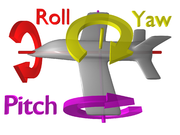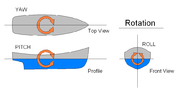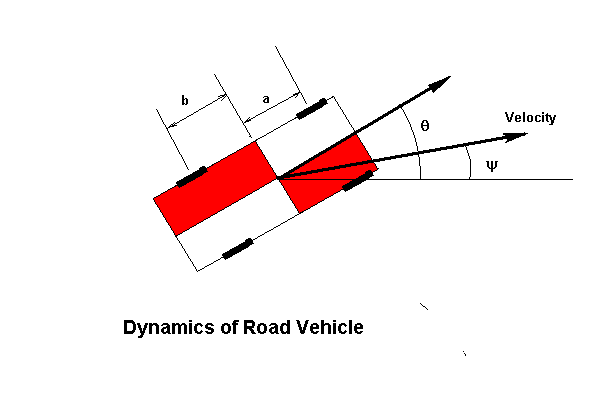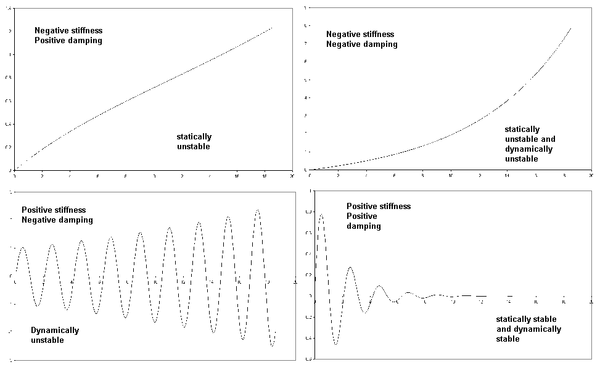
Yaw rate
Encyclopedia

Aircraft principal axes
An aircraft in flight is free to rotate in three dimensions: pitch, nose up or down about an axis running from wing to wing), yaw, nose left or right about an axis running up and down; and roll, rotation about an axis running from nose to tail. The axes are alternatively designated as lateral,...
of a vehicle. It is commonly measured in degrees per second or radians per second.
In the general case, is a quite different movement from an increment of its heading angle. Nevertheless, in vehicles that move on a plane like a car or a vessel, both movements are the same. The yaw axis is the only rotational degree of freedom.
The yaw rate or yaw velocity of a car or other rigid body is the angular velocity
Angular velocity
In physics, the angular velocity is a vector quantity which specifies the angular speed of an object and the axis about which the object is rotating. The SI unit of angular velocity is radians per second, although it may be measured in other units such as degrees per second, revolutions per...
of this rotation, or rate of change of the heading angle when the aircraft is horizontal.
Another important concept is the yaw moment
Moment (physics)
In physics, the term moment can refer to many different concepts:*Moment of force is the tendency of a force to twist or rotate an object; see the article torque for details. This is an important, basic concept in engineering and physics. A moment is valued mathematically as the product of the...
, or yawing moment, which is the projection of a given torque
Torque
Torque, moment or moment of force , is the tendency of a force to rotate an object about an axis, fulcrum, or pivot. Just as a force is a push or a pull, a torque can be thought of as a twist....
over the Yaw axis. It is specially important in road vehicles because Pitch and Roll moments are suppressed by the floor reaction.
Measurement
Yaw velocity can be measured by measuring the ground velocity at two geometrically separated points on the body, or by a gyroscopeGyroscope
A gyroscope is a device for measuring or maintaining orientation, based on the principles of angular momentum. In essence, a mechanical gyroscope is a spinning wheel or disk whose axle is free to take any orientation...
, or it can be synthesized from accelerometers and the like. It is the primary measure of how drivers sense a car's turning visually.

Electronic stability control
Electronic stability control is a computerized technology that may potentially improve the safety of a vehicle's stability by detecting and minimizing skids. When ESC detects loss of steering control, it automatically applies the brakes to help "steer" the vehicle where the driver intends to go...
vehicles. The Yaw rate is directly related to the lateral acceleration of the vehicle turning at constant speed around a constant radius, by the relationship
- tangential speed*yaw velocity = lateral acceleration = tangential speed^2/radius of turn, in appropriate units
The sign convention can be established by rigorous attention to coordinate systems.
In a more general manoeuvre
Basic fighter maneuvers
Basic fighter maneuvers are tactical movements performed by fighter aircraft during air combat maneuvering , in order to gain a positional advantage over the opponent. BFM combines the fundamentals of aerodynamic flight and the geometry of pursuit with the physics of managing the aircraft's...
where the radius is varying, and/or the speed is varying, the above relationship no longer holds.
The yaw rate anyway can still be meassured with accelerometers in the vertical axis. Any device intended to measure the Yaw rate is called a Yaw rate sensor
Yaw rate sensor
A yaw rate sensor is a gyroscopic device that measures a vehicle’s angular velocity around its vertical axis. The output is usually in degrees per second or radians per second. The angle between the vehicle's heading and vehicle actual movement direction is called slip angle, which is related to...
.
Yaw rate control
Yaw rate control is a system that maintains the yaw rate of a vehicle, for example a car, according to the values requested by the driver. It differs from simple Yaw control because is not the heading angle the controlled variable, but its variation rate instead.It is one of the main targets of the Electronic stability control
Electronic stability control
Electronic stability control is a computerized technology that may potentially improve the safety of a vehicle's stability by detecting and minimizing skids. When ESC detects loss of steering control, it automatically applies the brakes to help "steer" the vehicle where the driver intends to go...
systems. Arrows, darts, rockets and airships have tail surfaces to achieve stability. A road vehicle does not have elements specifically designed to maintain stability, but relies primarily on the distribution of mass
Mass
Mass can be defined as a quantitive measure of the resistance an object has to change in its velocity.In physics, mass commonly refers to any of the following three properties of matter, which have been shown experimentally to be equivalent:...
.
Road Vehicles
While studying the stability of a road vehicle is required a reasonable approximation to the equations of motion.
 (theta) whilst it is travelling in a direction
(theta) whilst it is travelling in a direction  (psi). In general, these are not the same. The tyre treads at the region of contact point in the direction of travel, but the hubs are aligned with the vehicle body, with the steering
(psi). In general, these are not the same. The tyre treads at the region of contact point in the direction of travel, but the hubs are aligned with the vehicle body, with the steeringSteering
Steering is the term applied to the collection of components, linkages, etc. which will allow a vessel or vehicle to follow the desired course...
held central. The tyres distort as they rotate to accommodate this mis-alignment, and generate side forces as a consequence.
From Directional stability
Directional stability
Directional stability is stability of a moving body or vehicle about an axis which is perpendicular to its direction of motion. Stability of a vehicle concerns itself with the tendency of a vehicle to return to its original direction in relation to the oncoming medium when disturbed away from...
study, denoting the angular velocity
 , the equations of motion are:
, the equations of motion are:

The coefficient of
 will be called the 'damping
will be called the 'dampingDamping
In physics, damping is any effect that tends to reduce the amplitude of oscillations in an oscillatory system, particularly the harmonic oscillator.In mechanics, friction is one such damping effect...
' by analogy with a mass-spring-damper which has a similar equation of motion. By the same analogy, the coefficient of
 will be called the 'stiffness', as its function is to return the system to zero deflection, in the same manner as a spring.
will be called the 'stiffness', as its function is to return the system to zero deflection, in the same manner as a spring.The form of the solution depends only on the signs of the damping and stiffness terms. The four possible solution types are presented in the figure.

The only satisfactory solution requires both stiffness and damping to be positive. If the centre of gravity is ahead of the centre of the wheelbase
Wheelbase
In both road and rail vehicles, the wheelbase is the distance between the centers of the front and rear wheels.- Road :In automobiles, the wheelbase is the horizontal distance between the center of the front wheel and the center of the rear wheel...
(
 , this will always be positive, and the vehicle will be stable at all speeds. However, if it lies further aft, the term has the potential of becoming negative above a speed given by:
, this will always be positive, and the vehicle will be stable at all speeds. However, if it lies further aft, the term has the potential of becoming negative above a speed given by:Above this speed, the vehicle will be directionally (Yaw) unstable. Corrections for Relative Effect of Front and Rear Tyres and Steering Forces are available in the main article.
Relationship with other rotation systems
These rotations are intrinsic rotationsMoving frame
In mathematics, a moving frame is a flexible generalization of the notion of an ordered basis of a vector space often used to study the extrinsic differential geometry of smooth manifolds embedded in a homogeneous space.-Introduction:...
and the calculus behind them is similar to the Frenet-Serret formulas
Frenet-Serret formulas
In vector calculus, the Frenet–Serret formulas describe the kinematic properties of a particle which moves along a continuous, differentiable curve in three-dimensional Euclidean space R3...
. Performing a rotation in an intrinsic reference frame is equivalent to right-multiply its characteristic matrix (the matrix that has the vector of the reference frame as columns) by the matrix of the rotation.
History
The first aircraft to demonstrate active control about all three axes was the Wright brothersWright brothers
The Wright brothers, Orville and Wilbur , were two Americans credited with inventing and building the world's first successful airplane and making the first controlled, powered and sustained heavier-than-air human flight, on December 17, 1903...
' 1902 glider.
See also
- Aircraft principal axesAircraft principal axesAn aircraft in flight is free to rotate in three dimensions: pitch, nose up or down about an axis running from wing to wing), yaw, nose left or right about an axis running up and down; and roll, rotation about an axis running from nose to tail. The axes are alternatively designated as lateral,...
- Coriolis acceleration
- Lateral acceleration
- Yaw rate sensorYaw rate sensorA yaw rate sensor is a gyroscopic device that measures a vehicle’s angular velocity around its vertical axis. The output is usually in degrees per second or radians per second. The angle between the vehicle's heading and vehicle actual movement direction is called slip angle, which is related to...
- Adverse yawAdverse yawAdverse yaw is a yaw moment on an aircraft which results from an aileron deflection and a roll rate, such as when entering or exiting a turn. It is called "adverse" because it acts opposite to the yaw moment needed to execute the desired turn. Adverse yaw has three mechanisms, listed below in...
- Directional stabilityDirectional stabilityDirectional stability is stability of a moving body or vehicle about an axis which is perpendicular to its direction of motion. Stability of a vehicle concerns itself with the tendency of a vehicle to return to its original direction in relation to the oncoming medium when disturbed away from...
- Vehicle dynamicsVehicle dynamicsVehicle dynamics refers to the dynamics of vehicles, here assumed to be ground vehicles. Vehicle dynamics is a part of engineering primarily based on classical mechanics but it may also involve chemistry, solid state physics, electrical engineering, communications, psychology, control theory,...
- Six degrees of freedomSix degrees of freedomSix degrees of freedom refers to motion of a rigid body in three-dimensional space, namely the ability to move forward/backward, up/down, left/right combined with rotation about three perpendicular axes...


